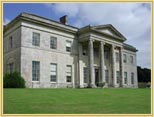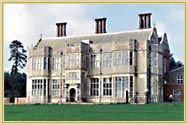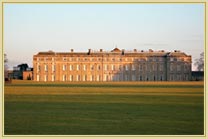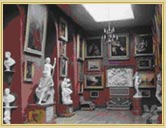WYNDHAM HOUSES IN ENGLAND
Dinton
 Designed by Jeffry Wyatville for William Wyndham, the house was completed in 1820. The principal rooms on the ground floor are open to visitors and contain fine Regency furniture. Both the house and the surrounding landscape park have recently been restored.
Designed by Jeffry Wyatville for William Wyndham, the house was completed in 1820. The principal rooms on the ground floor are open to visitors and contain fine Regency furniture. Both the house and the surrounding landscape park have recently been restored.
Felbrigg
 This handsome house, home of the Windham family and their descendants from the 15th century until 1969, owes much of its splendour to William Windham II. After his protracted five-year Grand Tour, Windham remodelled the interior in the 1750s to provide a sumptuous setting for his magnificent art treasures. The state rooms he created contain superb 18th-century furniture and paintings, and there is an outstanding library. The domestic wing offers a startling contrast between life above and below stairs.
This handsome house, home of the Windham family and their descendants from the 15th century until 1969, owes much of its splendour to William Windham II. After his protracted five-year Grand Tour, Windham remodelled the interior in the 1750s to provide a sumptuous setting for his magnificent art treasures. The state rooms he created contain superb 18th-century furniture and paintings, and there is an outstanding library. The domestic wing offers a startling contrast between life above and below stairs.
The walled garden is complete with greenhouses and box-edged herbaceous borders. The orangery has a fine display of camellias in spring. There is also an interesting octagonal dovecote (with doves) and small orchard, and delightful waymarked walks lead through the surrounding woods and parkland and alongside the lake. The National Collection of Colchicums is on view in late summer/early autumn.
Orchard Wyndham
 In 1523, John Wyndham returned to England after 10 years in France. He found his sister, Margaret, married to Sir Andrew Luttrell of Dunster, and, while visiting her, he met Elizabeth Sydenham, and married her in 1528. Since the death of her brother without issue, she had been the owner of the Sydenham home at Orchard and of the family estates. The marriage, therefore, was unquestionably one of "inheritance in land" such as John's father would have approved.
In 1523, John Wyndham returned to England after 10 years in France. He found his sister, Margaret, married to Sir Andrew Luttrell of Dunster, and, while visiting her, he met Elizabeth Sydenham, and married her in 1528. Since the death of her brother without issue, she had been the owner of the Sydenham home at Orchard and of the family estates. The marriage, therefore, was unquestionably one of "inheritance in land" such as John's father would have approved.
No family had been more prominent and influential in Somerset than the Sydenhams. But, it was now approaching the end of its period of ascendancy. The Orchard branch was merged into the Wyndhams by Elizabeth's marriage to John.
John's marriage resulted in his branch of the family becoming domiciled in Somerset instead of in Norfolk. On this account too, and because for some inscrutable reason Wyndhams in Somerset were more prolific than in Norfolk, the house at Orchard Wyndham and the ancient parish church of St. Decuman's nearby became the chief centres of family history and tradition.
The house is an architectural puzzle. In it may still be discerned many remains of the original Sydenham abode incorporated into the alterations and additions of subsequent generations. The church, two miles distant, standing on an eminence inconveniently remote from the habitations of the parishioners because Satan himself intervened to prevent its being built elsewhere, is architecturally more beautiful and less baffling. No more fitting shrine for family memorials could be imagined.
Petworth
 The vast late 17th-century mansion is set in a beautiful park, landscaped by ‘Capability’ Brown and immortalised in Turner's paintings. The house contains the Trust's finest and largest collection of pictures, with numerous works by Turner, Van Dyck, Reynolds and Blake, as well as ancient and neo-classical sculpture, fine furniture and carvings by Grinling Gibbons. The Servants' Quarters contain interesting kitchens (including a splendid copper batterie de cuisine of over 1000 pieces) and other service rooms.
The vast late 17th-century mansion is set in a beautiful park, landscaped by ‘Capability’ Brown and immortalised in Turner's paintings. The house contains the Trust's finest and largest collection of pictures, with numerous works by Turner, Van Dyck, Reynolds and Blake, as well as ancient and neo-classical sculpture, fine furniture and carvings by Grinling Gibbons. The Servants' Quarters contain interesting kitchens (including a splendid copper batterie de cuisine of over 1000 pieces) and other service rooms.
